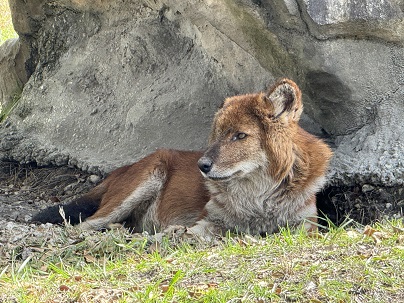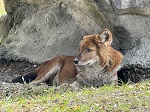| NAME OF ANIMAL | FAMILY | DESCRIPTION |
| DHOLE | CANIDAE | The dhole is set apart from other canids in that it has an unusually thick muzzle and one less molar tooth on each side of its lower jaw. The adult dhole is characterized by a rusty red coat with a pale underside; depending on the region, pelage may vary from light brownish gray to a uniform red coat. A dhole is born with a sooty brown color, acquiring an adult color at three months of age. Dholes also have dark, almost always black, bushy tails. |
| MEASUREMENT | MALE | FEMALE |
| HEAD TO BODY LENGTH | 15 to 21 kg (33 to 46 lb) | 10 to 17 kg (22 to 37 lb) |
| SHOULDER HEIGHT | 50 cm (20 in) | 50 cm (20 in) |
| TAIL LENGTH | 15 to 18 inches (40 to 45 centimeters) | 15 to 18 inches (40 to 45 centimeters) |
| WEIGHT | weighing 14 to 18 kilograms (31 to 40 pounds). | 12 to 16 kilograms (26 to 35 pounds) |
| CHARACTERISTICS | DESCRIPTION |
| RANGE | From the Altai Mountains in Manchuria in Central and Eastern Asia, its range spreads southwards through the forest tracts of India, Burma, and the Malayan Archipelago. Three races of the dhole exist in India alone. |
| HABITAT | Dholes like open spaces and can often be found on jungle roads, river beds, jungle clearings, and paths, where they rest during the day. |
| PRIMARY DIET | OMNIVORE |
| DIET | The dhole eats wild berries, insects, and lizards. Packs of dholes feast on mammals ranging from rodents to deer. Some of the dhole’s favorites include wild pigs, hares, wild goats, sheep, and occasionally a monkey. |
| CONSERVATION STATUS | 949-2,215 mature individuals |
| REASON FOR THE STATUS | One of the main threats to the dhole is a lack of prey animals. Today the dhole itself is not heavily hunted by humans either for its fur or for its coat, but the animals on which it preys are. With a lack of prey animals, an ecosystem is unable to support predators such as dholes which reside further up the food chain. Today, much of the dhole’s historic habitat has been converted into plantations, farms and towns. The increased human presence in areas in which dholes live leads to conflicts. |
| CHARACTERISTICS | DESCRIPTION |
| REPRODUCTION | DHOLES GENERALLY BREED ONCE A YEAR, WITH MATING TYPICALLY OCCURRING BETWEEN NOVEMBER AND DECEMBER. |
| GESTATION PERIOD | 60-63 DAYS |
| YOUNG PER BIRTH | 6-12 (12 PUPS ) |
| WEANING | 58 DAYS |
| SEXUAL MATURITY | THE PUPS REACH SEXUAL MATURITY AT ABOUT A YEAR |
| BEHAVIOR | DHOLES ARE DIURNAL ANIMALS, BEING MOST ACTIVE DURING THE DAY. THEY ARE KNOWN FOR THEIR EXTRAORDINARY STAMINA AND CAN TRAVERSE LONG DISTANCES IN SEARCH OF FOOD OR DURING MIGRATION. |
| MAIN PREADATOR | MAIN PREDATORS OF THE DHOLE ARE TIGERS AND LEOPARDS |
| LIFESPAN IN THE WILD | 10-13 YEARS IN THE WILD |
| LIFESPAN IN CAPTIVITY | 16 YEARS IN CAPTIVITY |




